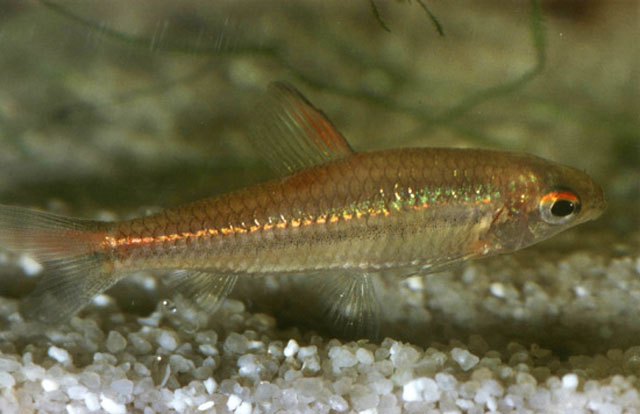| Distichodontidae (Distichodus) |
| 6.2 cm TL (male/unsexed) |
|
pelagic; freshwater; pH range: 6.5 - 7.5; dH range: 12, |
| Africa: Niger and Cross River in Nigeria (Ref. 2936, 31256, 86396) and Chad basin (Ref. 367, 86396). Found in Cameroon, Gabon, Equatorial Guinea, DRCongo, Republic of Congo, Cabinda (Ref. 81638). Also reported from Ghana (Ref. 11235) and the lower part of the Congo basin (Ref. 2936, 94734). Reports from other parts of the Congo basin (Ref. 1878, 1879, 41591, 46861) need confirmation. |
|
Dorsal spines (total): 0-0; Dorsal soft rays (total): 12-14; Anal spines: 0-0; Anal soft rays: 9-11. Diagnosis: distinguished from Neolebias by its always complete lateral line; caudal peduncle 1-1.5x longer that high (Ref. 2936, 86396). 32-36 scales in a longitudinal series (Ref. 81638, 86396). Four, rarely 5, scales between dorsal fin origin and lateral line (Ref. 81638). 11-16 (Ref. 86396) or 12-14 (Ref. 81638) total dorsal fin rays. 10 (Ref. 86396) or 9-11 (Ref. 81638) total anal fin rays.
Description: small elongate fish, body moderately deep, 0.28-0.38 SL and laterally compressed; mouth terminal with two rows of bicuspid teeth in each jaw (Ref. 2936, 81638, 86396). Maxilla extending to the anterior border of eyes (Ref. 2936, 86396). Premaxilla with 11-12 teeth in outer row, maxilla with 2-3 teeth along anterodorsal margin, dentary with 11-12 teeth in outer row; adipose fin present; 4 scales between lateral line and anal fin origin; D: III,9-11; A: II-III,7-8 (Ref. 81638).
Coloration: preserved specimens yellowish tan; dark chromatophores on upper lip, snout and head; field of dark chromatophores extending from behind orbit to rear of opercle, sometimes forming horizontal band continuous with dark mid-lateral band on body; scales dorsal to lateral line with exposed portion of scale dark other than for ctenii and immediately adjoining portion of main body of scale; caudal fin with dark band on middle rays and with scattered dark chromatophores on remainder of fin; anterior rays of dorsal fin with dark chromatophores; chromatophore field denser on distal portions of rays; remainder of dorsal fin and central portions of pelvic and pectoral fins with scattered chromatophores; live specimens with dark mid-lateral band prominent and with dorsal and caudal fins suffused with red, more so in males (Ref. 81638). Back olivaceous-grey, lower parts and belly whitish; dark mid-lateral band from eye to caudal fin, comprising lower thirds of lateral-line scales and two thirds of those in next-lower series; black spot on dorsal-fin tip (Ref. 2936, 86396). |
| Distinguished from Neolebias by its always complete lateral line (Ref. 2936). Feeds on worms, crustaceans and insects (Ref. 7020). |
|
Least Concern (LC); Date assessed: 11 May 2019 Ref. (130435)
|
| harmless |
Source and more info: www.fishbase.org. For personal, classroom, and other internal use only. Not for publication.
